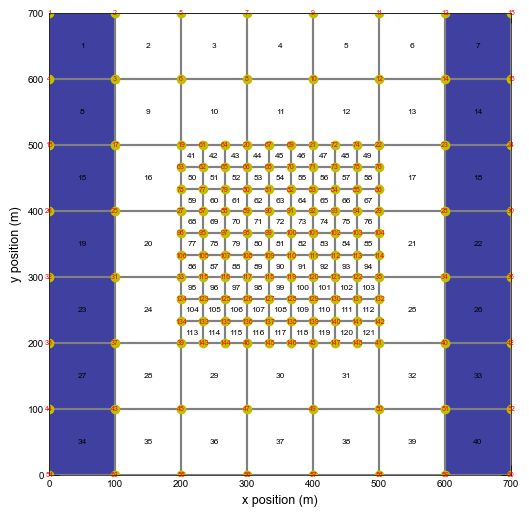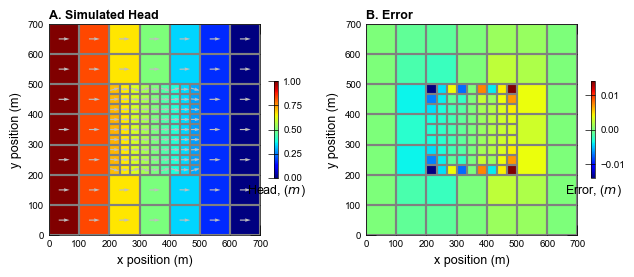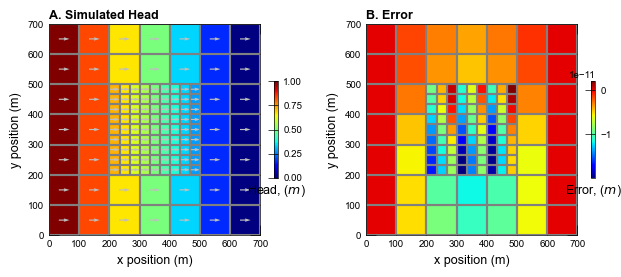This page was generated from
ex-gwf-u1disv.py.
It's also available as a notebook.
USG1DISV example
This example shows how the MODFLOW 6 DISV Package can be used to simulate a nested grid problem. The example corresponds to the first example described in the MODFLOW-USG documentation. The problem is run without and with the XT3D option of the NPF Package to improve the solution.
Initial setup
Import dependencies, define the example name and workspace, and read settings from environment variables.
[1]:
import os
import pathlib as pl
import flopy
import flopy.utils.cvfdutil
import git
import matplotlib.pyplot as plt
import numpy as np
from flopy.plot.styles import styles
from modflow_devtools.misc import get_env, timed
# Example name and workspace paths. If this example is running
# in the git repository, use the folder structure described in
# the README. Otherwise just use the current working directory.
try:
root = pl.Path(git.Repo(".", search_parent_directories=True).working_dir)
except:
root = None
workspace = root / "examples" if root else pl.Path.cwd()
figs_path = root / "figures" if root else pl.Path.cwd()
# Settings from environment variables
write = get_env("WRITE", True)
run = get_env("RUN", True)
plot = get_env("PLOT", True)
plot_show = get_env("PLOT_SHOW", True)
plot_save = get_env("PLOT_SAVE", True)
Define parameters
Define model units, parameters and other settings.
[2]:
# Model units
length_units = "meters"
time_units = "days"
# Scenario-specific parameters
parameters = {
"ex-gwf-u1disv": {
"xt3d": False,
},
"ex-gwf-u1disv-x": {
"xt3d": True,
},
}
# Model parameters
nper = 1 # Number of periods
nlay = 1 # Number of layers
top = 0.0 # Top of the model ($m$)
botm = -100.0 # Layer bottom elevations ($m$)
strt = 0.0 # Starting head ($m$)
icelltype = 0 # Cell conversion type
k11 = 1.0 # Horizontal hydraulic conductivity ($m/d$)
# Static temporal data used by TDIS file
# Simulation has 1 steady stress period (1 day)
# and 3 transient stress periods (10 days each).
# Each transient stress period has 120 2-hour time steps.
perlen = [1.0]
nstp = [1]
tsmult = [1.0, 1.0, 1.0]
tdis_ds = list(zip(perlen, nstp, tsmult))
# create the disv grid
# outer grid
nlay = 1
nrow = ncol = 7
delr = 100.0 * np.ones(ncol)
delc = 100.0 * np.ones(nrow)
tp = np.zeros((nrow, ncol))
bt = -100.0 * np.ones((nlay, nrow, ncol))
idomain = np.ones((nlay, nrow, ncol))
idomain[:, 2:5, 2:5] = 0
sg1 = flopy.discretization.StructuredGrid(
delr=delr, delc=delc, top=tp, botm=bt, idomain=idomain
)
# inner grid
nlay = 1
nrow = ncol = 9
delr = 100.0 / 3.0 * np.ones(ncol)
delc = 100.0 / 3.0 * np.ones(nrow)
tp = np.zeros((nrow, ncol))
bt = -100 * np.ones((nlay, nrow, ncol))
idomain = np.ones((nlay, nrow, ncol))
sg2 = flopy.discretization.StructuredGrid(
delr=delr,
delc=delc,
top=tp,
botm=bt,
xoff=200.0,
yoff=200,
idomain=idomain,
)
# get the disv grid arguments
gridprops = flopy.utils.cvfdutil.gridlist_to_disv_gridprops([sg1, sg2])
# Solver parameters
nouter = 50
ninner = 100
hclose = 1e-9
rclose = 1e-6
Model setup
Define functions to build models, write input files, and run the simulation.
[3]:
def build_models(sim_name, xt3d):
sim_ws = os.path.join(workspace, sim_name)
sim = flopy.mf6.MFSimulation(sim_name=sim_name, sim_ws=sim_ws, exe_name="mf6")
flopy.mf6.ModflowTdis(sim, nper=nper, perioddata=tdis_ds, time_units=time_units)
flopy.mf6.ModflowIms(
sim,
linear_acceleration="bicgstab",
outer_maximum=nouter,
outer_dvclose=hclose,
inner_maximum=ninner,
inner_dvclose=hclose,
rcloserecord=f"{rclose} strict",
)
gwf = flopy.mf6.ModflowGwf(sim, modelname=sim_name, save_flows=True)
flopy.mf6.ModflowGwfdisv(
gwf,
length_units=length_units,
nlay=nlay,
top=top,
botm=botm,
**gridprops,
)
flopy.mf6.ModflowGwfnpf(
gwf,
icelltype=icelltype,
k=k11,
save_specific_discharge=True,
xt3doptions=xt3d,
)
flopy.mf6.ModflowGwfic(gwf, strt=strt)
chd_spd = []
chd_spd += [[0, i, 1.0] for i in [0, 7, 14, 18, 22, 26, 33]]
chd_spd = {0: chd_spd}
flopy.mf6.ModflowGwfchd(
gwf,
stress_period_data=chd_spd,
pname="CHD-LEFT",
filename=f"{sim_name}.left.chd",
)
chd_spd = []
chd_spd += [[0, i, 0.0] for i in [6, 13, 17, 21, 25, 32, 39]]
chd_spd = {0: chd_spd}
flopy.mf6.ModflowGwfchd(
gwf,
stress_period_data=chd_spd,
pname="CHD-RIGHT",
filename=f"{sim_name}.right.chd",
)
head_filerecord = f"{sim_name}.hds"
budget_filerecord = f"{sim_name}.cbc"
flopy.mf6.ModflowGwfoc(
gwf,
head_filerecord=head_filerecord,
budget_filerecord=budget_filerecord,
saverecord=[("HEAD", "ALL"), ("BUDGET", "ALL")],
)
return sim
def write_models(sim, silent=True):
sim.write_simulation(silent=silent)
@timed
def run_models(sim, silent=False):
success, buff = sim.run_simulation(silent=silent, report=True)
assert success, buff
# ### Plotting results
#
# Define functions to plot model results.
[4]:
# Figure properties
figure_size = (6, 6)
def plot_grid(idx, sim):
with styles.USGSMap():
sim_name = list(parameters.keys())[idx]
sim_ws = os.path.join(workspace, sim_name)
gwf = sim.get_model(sim_name)
fig = plt.figure(figsize=figure_size)
fig.tight_layout()
ax = fig.add_subplot(1, 1, 1, aspect="equal")
pmv = flopy.plot.PlotMapView(model=gwf, ax=ax, layer=0)
pmv.plot_grid()
pmv.plot_bc(name="CHD-LEFT", alpha=0.75)
pmv.plot_bc(name="CHD-RIGHT", alpha=0.75)
ax.set_xlabel("x position (m)")
ax.set_ylabel("y position (m)")
for i, (x, y) in enumerate(
zip(gwf.modelgrid.xcellcenters, gwf.modelgrid.ycellcenters)
):
ax.text(
x,
y,
f"{i + 1}",
fontsize=6,
horizontalalignment="center",
verticalalignment="center",
)
v = gwf.disv.vertices.array
ax.plot(v["xv"], v["yv"], "yo")
for i in range(v.shape[0]):
x, y = v["xv"][i], v["yv"][i]
ax.text(
x,
y,
f"{i + 1}",
fontsize=5,
color="red",
horizontalalignment="center",
verticalalignment="center",
)
if plot_show:
plt.show()
if plot_save:
fpth = figs_path / f"{sim_name}-grid.png"
fig.savefig(fpth)
def plot_head(idx, sim):
with styles.USGSMap():
sim_name = list(parameters.keys())[idx]
sim_ws = os.path.join(workspace, sim_name)
gwf = sim.get_model(sim_name)
fig = plt.figure(figsize=(7.5, 5))
fig.tight_layout()
head = gwf.output.head().get_data()[:, 0, :]
# create MODFLOW 6 cell-by-cell budget object
qx, qy, qz = flopy.utils.postprocessing.get_specific_discharge(
gwf.output.budget().get_data(text="DATA-SPDIS", totim=1.0)[0],
gwf,
)
ax = fig.add_subplot(1, 2, 1, aspect="equal")
pmv = flopy.plot.PlotMapView(model=gwf, ax=ax, layer=0)
pmv.plot_grid()
cb = pmv.plot_array(head, cmap="jet")
pmv.plot_vector(
qx,
qy,
normalize=False,
color="0.75",
)
cbar = plt.colorbar(cb, shrink=0.25)
cbar.ax.set_xlabel(r"Head, ($m$)")
ax.set_xlabel("x position (m)")
ax.set_ylabel("y position (m)")
styles.heading(ax, letter="A", heading="Simulated Head")
ax = fig.add_subplot(1, 2, 2, aspect="equal")
pmv = flopy.plot.PlotMapView(model=gwf, ax=ax, layer=0)
pmv.plot_grid()
x = np.array(gwf.modelgrid.xcellcenters) - 50.0
slp = (1.0 - 0.0) / (50.0 - 650.0)
heada = slp * x + 1.0
cb = pmv.plot_array(head - heada, cmap="jet")
cbar = plt.colorbar(cb, shrink=0.25)
cbar.ax.set_xlabel(r"Error, ($m$)")
ax.set_xlabel("x position (m)")
ax.set_ylabel("y position (m)")
styles.heading(ax, letter="B", heading="Error")
if plot_show:
plt.show()
if plot_save:
fpth = figs_path / f"{sim_name}-head.png"
fig.savefig(fpth)
def plot_results(idx, sim, silent=True):
if idx == 0:
plot_grid(idx, sim)
plot_head(idx, sim)
Running the example
Define and invoke a function to run the example scenario, then plot results.
[5]:
def simulation(idx, silent=True):
key = list(parameters.keys())[idx]
params = parameters[key].copy()
sim = build_models(key, **params)
if write:
write_models(sim, silent=silent)
if run:
run_models(sim, silent=silent)
if plot:
plot_results(idx, sim, silent=silent)
Run the USG1DISV model without XT3D, then plot heads.
[6]:
simulation(0)
<flopy.mf6.data.mfstructure.MFDataItemStructure object at 0x7faf81215400>
run_models took 29.02 ms


Run the USG1DISV model with XT3D, then plot heads.
[7]:
simulation(1)
<flopy.mf6.data.mfstructure.MFDataItemStructure object at 0x7faf81215400>
run_models took 40.28 ms
